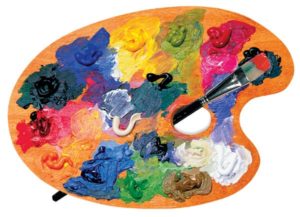
In my view Buddhism could benefit by developing approaches to teaching and learning that are widely used in art education. Such developments would require a radical rethink of some aspects of the teaching of Buddhist practice, particularly regarding the power relations involved, the desirability of developing independence rather than dependence, and a reorientation towards creative experiential learning rather than learning by rote or historical precedent. These changes to the way Buddhist practitioners learn and grow are all potentially controversial, and I offer these notes and suggestions as a way of initiating discussion and reflection. I hope they are useful.
In contemporary art education (in the UK) the aim is to enable an individual to realise his or her artistic nature, to realise their creative potential, and to wake up to who they are as an artist. In doing so the individual develops his or her own distinctive identity and ‘voice’, and contributes to their community and culture. Often this process is accompanied by a growing ease and peace of mind as the budding artist grows to live more in harmony with their own nature and with the world about them.
The underlying purpose of a Buddhist education is to enable an individual to realise his or her Buddha nature, to awaken to the primary conditions of existence, and to live in harmony with how things are (dharma) – in doing so, to enable anyone and everyone to realise his or her aspirations for self-realisation, independence and peace of mind – while also developing the aptitude for connectedness, kinship and compassion that arise with awakening.
This means that learning for oneself is of prime importance – working out one’s own path, while taking account of, but not being reliant upon, or attached to, the learning and teaching of others. At the end of his life, the Buddha’s final advice to his students was to remind them that, “All phenomena are subject to change – they are not lasting. Work hard to achieve your own awakening.” In other words, we should take responsibility for our own values and understanding, rather than deferring to, or being dependent upon, the understanding and values of another.
In contemporary art education the development of practice is paramount. The intention of a teacher is not to produce student clones or artist followers, or artists who make art in the same style or appearance as the teacher – indeed this would usually be considered a mark of failure, something to be avoided. The focus is primarily upon enabling the student to find her or his own distinctive way of being, knowing and doing. Teaching is often done by showing, pointing and questioning, as much as by telling, instructing or informing.
It is here, in relation to the methods and strategies used, that we begin to see differences between art education and Buddhist teaching. In Buddhism the dominant model is one of master and disciple – what in the art world is called the ‘atelier’ system – the apprentice artist working in the studio of the ‘master’, learning from his methods and imitating his style. Within the art world this model of teaching and learning was found to be unsatisfactory and moribund, unhelpful to students who were trying to find their own voice and creative identity. In the context of Buddhism there has been no equivalent reformation of educational practices. Given that Buddhism has developed for much of its history in societies that are rather conservative and hierarchical, often patriarchal and with a strong sense of orthodoxy, it is no surprise that the approach to teaching and learning is in many cases reflective of those ‘traditional’ values. But, just as educational methods in western societies have evolved as social structures and values have changed, so it may be time for similar changes to occur in the methods used in Buddhism. One aspect of the ‘secular’ Buddhist movement, involves developing just such new models of teaching and learning.
Given that experiencing and thinking for oneself is a key aspect of Buddhist practice, it is important that the process of awakening (the process of learning) is student-centred. In this context the relationship between individuals should be one of mutual respect and kinship – a situation in which everyone is a student and a teacher, each person learning from those around them and in this way helping everyone to grow towards realisation (the basis of a learning community or Sangha). Those with longer experience help those with shorter, and also learn from the fresh perspectives of new students. The interactions between teachers who are also students, and between students who are also teachers, is mutually beneficial – encouraging active, dynamic, experiential learning. This is potentially very different to the relationship between disciple and master, or follower and leader – which often becomes one of attachment, dependency and deferral.
As in art education, Buddhist learning could be articulated as a sequence of dialogues between participants rather than as a series of monologues centred on the words, opinions and values of the teacher. Everyone, students and teachers, take part in the collective enterprise of learning. Transactions between participants are conducted on the basis of exchanges of experience, knowledge and ideas between individuals – all of whom have a voice and a need to be taken seriously. The learning culture should provide a supportive and open forum within which dialogues are encouraged in as many different forms as possible.
